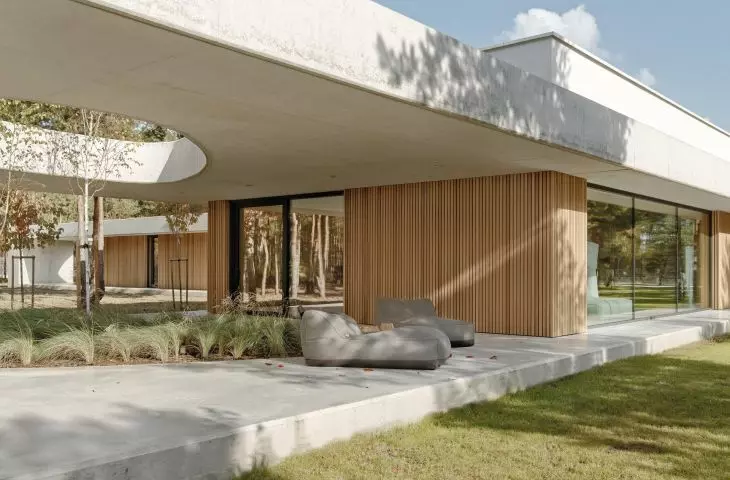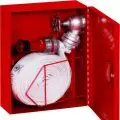The article comes from A&B issue 02|23
A conversation between Marta Kulawik and the founders of the Poznań-based studio PL.architekci, namely Katarzyna Cynka-Bajon and Bartek Bajon—a couple in private and professional life. Sweet about the satisfaction of designing admired and award-winning projects. Bitter about the winding road to the goal and bureaucracy clipping wings. We talk, among other things, about the condition of the profession in the Wielkopolska region and the visible changes that are taking place in Poznan. We point out the wasted public money and praise those well spent.
Katarzyna Cynka-Bajon and Bartłomiej Bajon
© PL.architekci
Marta Kulawik: You are members of the Wielkopolska Chamber of Architects of the Republic of Poland and design mainly in and around Poznań. Why such a strong focus on one city or province?
Katarzyna Cynka-Bajon: The simplest answer: because we want to have control over the project until the very end. And even though it is very tiring, it gives great satisfaction. We mainly design single-family houses with interiors for individual clients, and this is a very specific group of customers, requiring attentiveness and constant stimulation, because it is during the realization that strength and faith are most often lost. Besides, we like direct contact with clients: to get to know them, to bond with them, because this way we achieve a better result.
Bartek Bajon: However thoroughly a project is prepared, we believe that on such a small scale as houses and interiors, where you can tangibly see every detail, without our constant presence there is no way to complete the project with the effect we all want. After all, we have never cared about just making hyper-realistic visualizations of home designs with interiors decorated with top Italian brands. We aim for beautiful photos showing the immense amount of work put in. That's why we only do projects with author's supervision, which is often almost investment supervision. And because it requires a great deal of time, we have to work locally.
betOn house
Photo: Tom Kurek © PL.architekci
Marta: What condition must be met in order for you to agree to undertake cooperation away from the office?
Bartek: As a matter of fact, outside of Greater Poland, we have completed several projects for our regular clients: their houses or holiday apartments. But again, in order to make the result satisfactory for everyone, our regular and experienced group of contractors participated in these realizations.
The large glazing gives a soothing view of the trees on the plot and in the immediate vicinity;
one of the segments of the modular sofa faces the window, in opposition to the TV set
Photo: Tom Kurek © PL.architekci
Marta: You have managed to develop a certain recognizable design style, while at the same time each realization is completely different. What is the seed of each project?
Bartek: The idea. Without it there is no architecture only construction. We don't like the conglomeration of everything that is fashionable, because fashion passes and building is too expensive to afford temporariness. Our projects are very economical and calm in expression, without decoration, there is never any coincidence. We like how everything fits together, the lines meet at one point, harmony is created.
Katarzyna: We always have the same work pattern. First, talking to customers about how they live and what they need. Here we focus primarily on how the building should function. That's why we really talk about the interiors. Later there is a visit to the plot—and here, in most cases, comes the idea for the building. We always show clients a ready answer that we are sure of: projections, visualizations of the exterior and interior, because this is the only way to convince them of our idea. And it seems to work, because 95 percent of the design idea remains. There are sometimes cosmetic changes, less often slightly bigger ones, but when the idea is good, it doesn't matter anymore.
POZ_7 house
Photo: Tom Kurek © PL.architekci
Marta: The PL.architekci office has been in existence since 2005. Who was the first investor who decided to entrust the design and supervision of the realization of his house to a pair of students, how did you manage to convince him to do so?
Bartek: Our first project, and with realization, was a wedding gift for my brother, although it is said that the first project is done for the enemy. In addition, we were in our fourth year of college at the time (our friend Marcin Kozierowski was still designing with us). We found out that the concept and design are the easiest part of the whole process, and the hardest stage is the implementation (which later influenced the decision that we only design with author's supervision). My sister-in-law and brother always wanted to live in a modern, minimalist house, but there were no such houses at the time, and it was difficult to find studios specializing in this type of architecture. This is where we came in: enthralled by our travels to Berlin, which was under construction, young, we wanted to show that it was also possible to build like this in Poland. However, it quickly turned out that the solutions used abroad, for example, ordinary facade blinds, huge sliding windows, and doors that do not rebate to the ceiling, are crawling things in our country. Many times during the construction process we were berated by our brother for inventing something and then not knowing how to do it or where to buy it. But still, they trusted us to the end and believed in us. They were, without a doubt, such modern patrons. In the end, the project succeeded: it had many publications and became a kind of living museum, where we sometimes even came every week with potential new customers to trust us too. And so, despite our will, we pigeonholed ourselves into single-family architecture.
Implementation of the competition project for the Integrated Transportation Center in Wolsztyn;
view from the street of the modernized building
Photo: Nate Cook © PL.architekci
Marta: In the studio's portfolio, perhaps the only public project stands out, in addition to the competition project: the Integrated Communication Center in Wolsztyn. What prompted you to take part in the competition?
Bartek: Love for trains. I'm from the Wolsztyn area and steam locomotives (for which Wolsztyn is known) have been close to me since childhood. In addition, I have always been fascinated by the architecture of train stations. So everything spoke in favor of taking part in the competition. And, interestingly enough, it was the only project we did after hours.
The Wolsztyn train station is distinguished by its use of red;
this distinctive color consistently appears in many of the areas included in the design study
Photo: Nate Cook © PL.architekci
Marta: The level of detailing accuracy is impressive, is this the result of being used to designing on a small scale for a private investor and with an emphasis on detailing, including interiors?
Katarzyna: Yes, we don't know how to do things differently. Although we were operating on a large scale here, even the handles were under our control (we had author's supervision every week). Certainly, this is also due to the general contractor—a local company that builds most of our houses. From the very beginning, we also worked out with the ordering party a certain way of guarding our copyrights. Among other things, we prepared guidelines that were attached to contracts with tenants: what they can and can't do, for example, in terms of window cladding, use of colors. We hope this will help maintain quality.
Marta: How do you recall coming into contact with a slightly different developer than usual? Was it difficult to convince officials, such as the conservator, of your visions?
Bartek: Contrary to appearances, cooperation with the ordering party, which is the Wolsztyn Municipality, not PKP, was based on trust and respect for our vision and copyrights. The building is listed in the municipal register of monuments as an example of modernist architecture, and the whole concept was subject to agreement with the Provincial Conservator of Monuments Delegation in Leszno. What was our surprise when we presented the project in front of the now almost-retired conservator, who commented on our project with delight and joy, without making any comments!
Katarzyna: It was similar with the Provincial Office, which helped us a lot in obtaining a decision on the location of the public purpose or in obtaining the building permit itself. This was based on dialogue and partnership, and not—as it often seems—on proving our point. Especially since the project was implemented on both open and closed land, with different ownership structures. It required an environmental decision and many agreements, including with various railroad companies that we didn't even know existed. In fact, the worst cooperation was with the railroad companies.
Integrated Transportation Center in Wolsztyn
Photo: Nate Cook © PL.architekci
Marta: Why do you so rarely decide to participate in architectural competitions, especially after your success in the competition for the Wolsztyn train station?
Bartek: Despite the fact that the train station is the largest and probably the most legally complicated project, it was the one that was completed the fastest—in less than a year and a half. However, there is too much politics in all this, proving a point, especially with PKP. It happened that something at the design stage was agreed upon, and at the end of construction PKP wanted something completely different. And unnecessary nervous situations were created. Meanwhile, we like to savor and enjoy the design and implementation, and not waste time writing off constant letters and lawyers. We even got a call recently inviting us to participate in the design of stations on the railroad line to CPK, because we have perfect credentials, but we declined.
Katarzyna: We love our work, but we also want to have time for a normal life, family and children.
Marta: From the position of observers, can you point to a competition—organized, for example, by the SARP Poznań Branch—decided in recent years, which particularly appealed to you? Favorite realization of the project selected in the competition?
Bartek: We are most pleased that after so many years of effort the branch managed to organize the NAWW Architectural Award of the Wielkopolska Region. After all, there was no local award given to architectural realizations in our environment, except for the Jan Baptista Quadro Prize of the Mayor of the City of Poznań, but that's only for realizations in the city.
Katarzyna: And it's no longer about the awards themselves, it's about talking about architecture, promoting it, writing about it and reaching the ordinary public. Because this works for the benefit of the whole environment.
POZ_7 house
Photo: Tom Kurek © PL.architekci
Marta: How do you evaluate the operation of the Poznan Department of Architecture and the approach of officials to your unusual proposals for building blocks? Does experience help you overcome difficulties and make effective projects that do not directly meet the requirements of, for example, MPZP?
Bartek: Just today I once again have to prove that a square is a square, not a circle. Sometimes we really get fed up with it. It hurts, because each of our projects is created on the basis of extensive and in-depth analysis of the space in which it is to be built, and we get the answer that our building has a „futuristic form”. And even though the manager knows what we are designing, and is familiar with our buildings, he won't give us permission: let the governor decide. Unfortunately, officials read records very literally: when there is a provision in the plan for sloping roofs and we have some kind of dormer with a flat roof or a bay window, he won't allow it, because the plan literally says sloping roofs. It doesn't matter that the building looks like a barn with a pitched roof, a flat roof is ble and doesn't meet the provisions of the local plan.
Katarzyna: Statistically, one in ten of our projects doesn't get a building permit and we have to appeal to the governor. In most cases he admits we are right. We've also been to court before—and won!
Marta: What was the biggest absurdity related to the office or officials in your career?
Bartek: Probably the fact that for one house project we did not get a building permit from the City Hall—it was only given by the governor—and a few years later the same project was nominated—by the same entity—for the five most interesting architectural realizations in Poznań(the Jan Baptista Quadro Prize of the Mayor of Poznań).
Marta: Do you notice any changes over the past several years, for the better or for the worse, in terms of the flexibility of officials' approach to bold architectural ideas?
Bartek: I don't see a change, especially in the issuance of permits based on local plans, which are overwhelmingly written schematically or unmeritoriously. An example from another project and permit denial: a provision in the plan that the architecture is to adapt to regional architecture and local traditions through creative use of architectural details. And the entire neighborhood is built up with catalogers and Grievian cubes. Meanwhile, our building, which tries to find its way in this spatial chaos in a creative way, cannot get a permit.
A window running almost the entire length of the house frames the landscape,
and the fiber-cement exterior frame has its reflection inside as well
Photo: Tom Kurek © PL.architekci
Marta: How many projects are in various stages of development by the office at this point?
Bartek: I think more or less fifty, at different stages: concept, building design, detailed design, construction. Of course, design is a team effort, Kasia and I are a bit of the face of this, but it is a credit to our entire design team, it is currently made up of seven people, along with us, so it is also always presented to clients, actively participating with us in supervision, also in receiving awards.
Marta: Among these fifty projects, are there buildings that are not single-family homes or in a different location than Greater Poland?
Katarzyna: We are finishing the construction of a gymnasium in Książ Wielkopolski, and we have finished the concept for a market square in Śrem and the development of a square—a square in Zaniemyśl (here exactly after a very long battle with a conservator of monuments). So, further locally.
POZ_7 house, cross-section
© PL.architekci
Marta: In these difficult times, do you notice a decline in interest in individual house designs along with high-end interiors?
Bartek:Our client is specific, with a different wallet, so fortunately interest in our services is fairly stable.
Marta: What is the condition of the architectural profession in your well-known Poznan backyard?
Katarzyna: Although we also belong to the Poznan SARP or SAW (Society of Interior Architects), we are not very active members due to our large family. We also don't go, despite invitations, to industry meetings where you can get to know the environment better. Which is not to say that we are not up to date on local developments. Certainly the generational change in the Poznan SARP is positive—there is more activity in organizing architectural events, for example, and there is more talk about it in the architectural debate. We still dream of something like the Museum of Architecture in some public space—a place where the city's development plans and investments are shown. Architectural universities are still far from practitioners. Here there is still no dialogue and willingness to cooperate. More often you can see the efforts of students than the departmental authorities themselves.
Bartek: However, this does not change the fact that we always cheer for good architecture and know how to rejoice in the successes of others.
Marta: Can you name an example of badly spent public money, apart from the rightly criticized train station in Poznań?
Katarzyna: Our top ones are the Municipal Stadium and the Kaponiera traffic circle—an integrated center. Wasted multimillion-dollar investments that will be in the landscape for several decades. Objects that could have become beautiful city-forming symbols of Poznan. Of course, as is often the case in such investments, it is not always the architect's fault.
Marta: For the sake of balance, I will also ask about an example of money well spent on investments or activities of institutions—can you think of such an example?
Bartek: First of all, the improvement of urban space, and this is due to the bravery of former city artist Piotr Libicki. For many years of his work, he led to the removal of all illegal advertisements, giant billboards from the center proper. He changed the entire technical infrastructure (in the form of poles, lamp posts) from strong colors to gray. There is more order and tidiness.
The interiors of the POZ_7 house are consistent with the householders' favorite aesthetics and their fondness for nature;
cacti, which the investor collects, appear in many places
Photo: Tom Kurek © PL.architekci
Marta: What else do you think the positive changes in Poznan's urban space are based on?
Katarzyna: The city has been functioning differently for several years. It used to be that only the Old Town and the Market Square were meeting places. Today, in virtually every neighborhood, there are satellites of the Market in various forms, with restaurants, stores. The old and considered unsafe neighborhoods, by being densified with new buildings, have changed the structure of the population, and this has also affected people's behavior. A well-designed space undoubtedly works that way. People have started to go out into the streets, walking. Food gardens appear on the streets, there is urban bustle. You can also see more care for the common space, which manifests itself, for example, in cleaning up after their pets.
Marta: One such place is the Lazarski market, where you live (design: Authors' Architecture Studio—Jacek Bulat). What is there to like it for?
Bartek: As residents, we can't understand the constant criticism of this place: that it's too concrete, that there's not enough greenery (although there are trees planted around the whole space every 7 meters or so), that a ufo has landed. Meanwhile, it's very easy to forget what this place looked like just three or four years ago, that it was impossible to pass a stroller with a child, because the paving slabs were so crooked, and there was no greenery at all. We are now doing two urban space projects, and we know how difficult it is, for example, to convince the conservator: for him the market is a square, not a park, and there is no way there could be more greenery. You also have to remember how limited the budget was for this investment (and it also included the replacement of the entire underground infrastructure).
Katarzyna: You can see how the space has changed socially. Residents are sitting on benches, walking. Children are playing, riding rollerblades or bicycles. There is a pleasant bustle in the summer, even in the evening. The market itself is tidy. Actually, all the townhouses around have been renovated. Catering is appearing. Throughout the summer there was a cultural incubator organizing classes, workshops or performances.
Marta: Does renovation mean development?
Katarzyna: Unfortunately, looking at least at the examples mentioned above, it doesn't always. And it should!
Marta: In that case, is Poznań a good city to live in?
Bartek: We are incoming residents, although we have lived here for twenty-three years. We see how the city has changed just for a resident. It's not perfect yet, there's a lot to do, but we think it's developing in the right direction. We try, in our small way, to contribute so that others also live here well and nicely.
Marta: Finally: what renovation are you most looking forward to?
Bartek: I guess in agreement with Kasia we can say our house. It's a reconstruction (three walls are left proper) of a house in Old Grunwald (the so-called Ostroróg was designed by the city architect Wladyslaw Czarnecki in the late 1920s). Truly a shoemaker walks without shoes—even though we are supported by all our friendly contractors or suppliers in terms of execution, it drags and drags, and constantly something happens and doesn't fit.
Marta: So I am keeping my fingers crossed! I wish you a stress-free continuation of the project and a beautiful, satisfying result.





































































